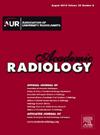A Deep Learning Model for Preoperative Prediction of Lymph Node Metastasis in cT1-Stage Lung Adenocarcinoma: A Multicenter External Validation Study
IF 3.9
2区 医学
Q1 RADIOLOGY, NUCLEAR MEDICINE & MEDICAL IMAGING
引用次数: 0
Abstract
Purpose
To develop and validate a deep learning (DL) model for preoperative prediction of lymph node metastasis (LNM) in clinical T1-stage lung adenocarcinoma (LUAD), and to compare its performance with conventional semantic and radiomics signatures.
Methods
This multicenter retrospective study enrolled 2503 patients with 2568 pathologically confirmed cT1-stage LUAD nodules from eight institutions. Data from six centers (1994 patients/2059 nodules) were randomly divided into training (1600 patients/1664 nodules) and internal test (394 patients/395 nodules) cohorts. Two independent external validation cohorts (Set-1: 283 patients/nodules; Set-2: 226 patients/nodules) were included. Three predictive models were developed as follows: 1) a semantic model incorporating spiculation, pleural traction, air bronchogram, and vacuole signs; 2) a radiomics model; and 3) ResLNM—a residual network-based DL model. Diagnostic performance was evaluated using the area under the receiver operating characteristic curve (AUC) and decision curve analysis (DCA).
Results
Both ResLNM and radiomics models significantly outperformed the semantic model in predicting LNM (AUC range: 0.71–0.85 and 0.72–0.84 vs. 0.58–0.74, respectively; P<0.05). While ResLNM demonstrated comparable performance to the radiomics model in the internal test set (AUC: 0.85, 0.81–0.89 vs. 0.84, 0.80–0.88; P = 0.624) and external validation set-2 (0.71, 0.63–0.79 vs. 0.72, 0.64–0.80; P = 0.472), it achieved superior accuracy in external validation set-1 (0.82, 0.76–0.88 vs. 0.77, 0.71–0.83; P = 0.039). DCA confirmed the clinical superiority of ResLNM. Notably, integrating ResLNM with either semantic or radiomics signatures provided no incremental value (P>0.05), whereas incorporating radiologically mediastinal enlarged lymph node status (short-axis diameter ≥10 mm) significantly enhanced predictive performance, achieving AUCs of 0.88 (95%CI:0.85–0.92), 0.89 (95%CI:0.84–0.94), and 0.76 (95%CI:0.68–0.83) in the test set and two validation cohorts, respectively.
Conclusion
The ResLNM model provides a clinically feasible tool for preoperative LNM prediction in cT1-stage LUAD, outperforming conventional semantic and radiomics approaches. Its performance can be further optimized by integrating routinely available lymph node size criteria, offering potential to refine surgical decision-making and reduce overtreatment.
基于深度学习模型的ct1期肺腺癌术前淋巴结转移预测:一项多中心外部验证研究
目的:建立并验证用于临床t1期肺腺癌(LUAD)术前淋巴结转移(LNM)预测的深度学习(DL)模型,并将其与传统语义和放射组学特征进行比较。方法:这项多中心回顾性研究纳入了来自8个机构的2503例病理证实的ct1期LUAD结节2568例。来自6个中心(1994例患者/2059个结节)的数据被随机分为训练组(1600例患者/1664个结节)和内部试验组(394例患者/395个结节)。两个独立的外部验证队列(Set-1: 283例患者/结节;Set-2:纳入226例患者/结节。建立了以下三种预测模型:1)语义模型,包括针状突起、胸膜牵拉、空气支气管图和液泡征象;2)放射组学模型;3)基于残差网络的深度学习模型reslnm。采用受试者工作特征曲线下面积(AUC)和决策曲线分析(DCA)评估诊断效果。结果:ResLNM和radiomics模型在预测LNM方面均显著优于语义模型(AUC范围分别为0.71-0.85和0.72-0.84 vs 0.58-0.74);而纳入纵隔淋巴结肿大(短轴直径≥10mm)的影像学检查显著提高了预测性能,在测试集和两个验证队列中分别实现了0.88 (95%CI:0.85-0.92)、0.89 (95%CI:0.84-0.94)和0.76 (95%CI:0.68-0.83)的auc。结论:ResLNM模型为ct1期LUAD的术前LNM预测提供了一种临床可行的工具,优于传统的语义和放射组学方法。通过整合常规可用的淋巴结大小标准,它的性能可以进一步优化,提供改进手术决策和减少过度治疗的潜力。
本文章由计算机程序翻译,如有差异,请以英文原文为准。
求助全文
约1分钟内获得全文
求助全文
来源期刊

Academic Radiology
医学-核医学
CiteScore
7.60
自引率
10.40%
发文量
432
审稿时长
18 days
期刊介绍:
Academic Radiology publishes original reports of clinical and laboratory investigations in diagnostic imaging, the diagnostic use of radioactive isotopes, computed tomography, positron emission tomography, magnetic resonance imaging, ultrasound, digital subtraction angiography, image-guided interventions and related techniques. It also includes brief technical reports describing original observations, techniques, and instrumental developments; state-of-the-art reports on clinical issues, new technology and other topics of current medical importance; meta-analyses; scientific studies and opinions on radiologic education; and letters to the Editor.
 求助内容:
求助内容: 应助结果提醒方式:
应助结果提醒方式:


